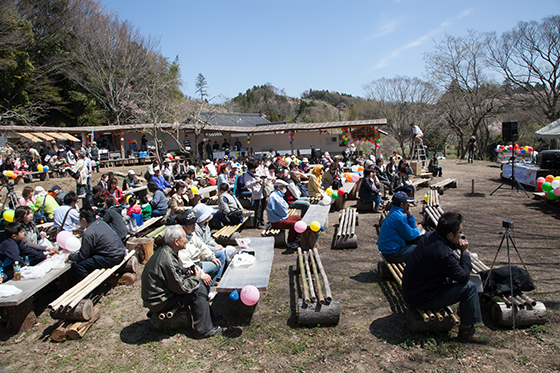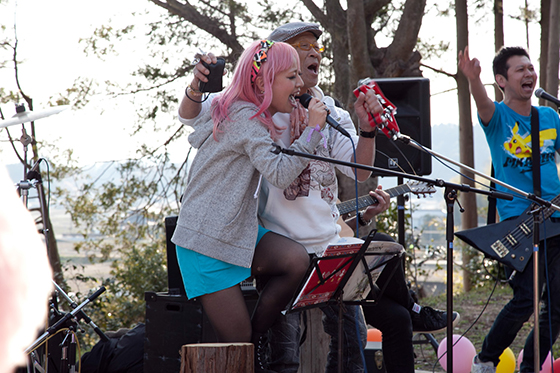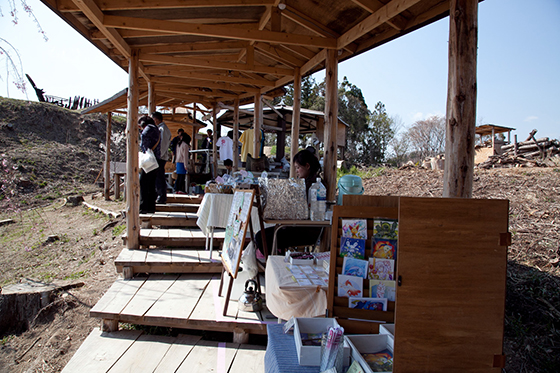Archive for April, 2014
Yatai Museum of Contemporary Art — 20th Anniversary of Cai Guo-Qiang and Iwaki
Posted by Cai Studio in Uncategorized on April 25, 2014

Installation view of YMoCA (Yatai Museum of Contemporary Art), Iwaki, Japan, 2014. Photo by Wen-You Cai, courtesy Cai Studio.
The Yatai Museum of Contemporary Art took place on April 12-13, 2014, in Iwaki, Fukushima, to celebrate the 20th anniversary of the friendship between Cai Guo-Qiang and Iwaki at the Snake Museum of Contemporary Art (SMoCA). Co-founded by Cai Studio and the Iwaki Board for the Project to Plant Ten Thousand Cherry Blossom Trees, SMoCA opened in Iwaki Fukushima, Japan last year. The opening of SMoCA marked the inauguration of the Project to Plant Ten Thousand Cherry Blossom Trees. This year, artist Cai Guo-Qiang acted as the director of SMoCA. Expanding upon last year’s project, three events were held to commemorate the twenty-year friendship between the artist and Iwaki:
Ⅰ. Yatai Museum of Contemporary Art (YMoCA):
Residents from Iwaki set up multiple yatai—or small, mobile food stands that prepare and sell small dishes—creating small dishes using local produce that were safe to consume. The gesture was meant to dispel any rumors that local seafood and agricultural products may be contaminated by nuclear radiation. Local residents also made handicrafts, which were for sale at the museum, transforming the site into a flea market. In addition, children’s drawings and sculptures were also on display at SMoCA.

Installation view of food stands at YMoCA (Yatai Museum of Contemporary Art), Iwaki, Japan, 2014. Photo by Wen-You Cai, courtesy Cai Studio.

Clown making balloon animals as part of YMoCA (Yatai Museum of Contemporary Art), Iwaki, Japan, 2014. Photo by Wen-You Cai, courtesy Cai Studio.
Ⅱ. Harajuku Kawaii (“cute”) Culture in Iwaki
Invited by artist Cai Guo-Qiang, Sebastian Masuda, one of the pioneers of Harajuku street culture in Tokyo, along with the band Nikoman brought a wave of Harajuku kawaii (“cute”) culture for the people and children in Iwaki village.
With assistance from the Iwaki Board, Sebastian Masuda organized a children’s workshop Let’s Make Some Kawaii Lanterns! with a local elementary school. Children were invited to design and make their own lanterns using kawaii, or “cute” materials, such as brightly colored soft toys, balls, and beads brought by Masuda. After the workshop, the children brought their works to SMoCA, and decorated the structure with their creations.

Students with lanterns they constructed in Sebastian Masuda’s Let’s Make Some Kawaii Lanterns, Iwaki, Japan, 2014. Photo by Wen-You Cai, courtesy Cai Studio.

Installation view of lanterns created by students at YMoCA (Yatai Museum of Contemporary Art), Iwaki, Japan, 2014. Photo by Wen-You Cai, courtesy Cai Studio.

Neeko and Iwaki resident performing together during Nikoman Show, Iwaki, Japan, 2014. Photo by Wen-You Cai, courtesy Cai Studio.
Ⅲ. Over a period of time, volunteers in Iwaki worked hard to extend SMoCA from 99 meters to 150 meters, linking the museum with Kaikou—The Keel (Returning Light—The Dragon Bone), a large-scale outdoor installation permanently installed on the hilltop of Tateyama, which has become a new local landmark.

Installation view of YMoCA (Yatai Museum of Contemporary Art), Iwaki, Japan, 2014. Photo by Wen-You Cai, courtesy Cai Studio.

Cai Guo-Qiang and Iwaki Team standing in front of Kaikou—The Keel (Returning Light—The Dragon Bone), Iwaki, Japan, 2014. Photo by Wen-You Cai, courtesy Cai Studio.
Twenty Years of Friendship between Cai Guo-Qiang and Iwaki
The friendship between artist Cai Guo-Qiang and the town of Iwaki, Fukushima, began in 1994. Local volunteers helped the artist realize Cai Guo-Qiang: From the Pan-Pacific, a landmark solo exhibition in his artistic career at the Iwaki City Art Museum, by excavating a fishing boat from the beach for the installation Kaikou-The Keel (Returning Light-the Dragon Bone). Cai was also able to fund the 5,000-meter long night-time explosion project, The Horizon from the Pan-Pacific: Project for Extraterrestrials No. 14, through contributions from the Iwaki people; local residents each sponsored 2,000 yen (about US$20) for one meter of gunpowder fuse. In 2004, to commemorate the tenth anniversary of the realization of The Horizon from the Pan-Pacific: Project for Extraterrestrials No. 14, the same team of volunteers and friends in Iwaki excavated another big boat from the same beach. Together with the boat, they traveled tens of thousands of miles to America for Cai’s exhibition at the Arthur M. Sackler Gallery of the Smithsonian Institution in Washington, D.C. The resulting installation work, Reflection—A Gift from Iwaki, has since toured all over the world; it has been exhibited at the National Gallery of Canada, Ottawa; the Guggenheim Museum in New York and in Bilbao; the Taipei Fine Arts Museum; and Musée d’art moderne et d’art contemporain, Nice. Every time the work is exhibited, the team from Iwaki follows the vessel and assembles it onsite. The friendship between Iwaki and the artist and the passage of time have become the core themes of the work.“We emerged from that small fishing village together and stepped out into the world,” said Cai Guo-Qiang, “Now our hair is turning white and our limbs are not as deft as they once were, yet thanks to art, we have stood by each other through thick and thin [even when our nations quarrel]. The heartfelt friendship of over two decades that I share with the people of Iwaki is rare and precious. Iwaki not only set the stage for my career early on, but it also gave me encouragement and recognition.”
In August 2012, the Iwaki team traveled to Copenhagen, Denmark, to assist with the installation of Reflection—A Gift from Iwaki during Cai’s solo exhibition, A Clan of Boats, at the Faurschou Foundation. With generous support and advocacy from the Foundation, the Project to Plant Ten Thousand Cherry Blossom Trees was able to move forward, and the funds raised enabled cherry trees to be planted on an entire mountain. In October of the same year, Cai was honored at the 24th Praemium Imperiale with a Lifetime Achievement award in the Arts (Painting). He decided at once to donate his award earnings—15 million yen in total (approx. US$150,000). Half was given to the Asian Cultural Council to sponsor young Japanese artists to pursue advanced studies in New York, and the other half was used to realize SMoCA and to complete the cherry blossom project.
Co-founded by Cai Studio and the Iwaki Board for the Project to Plant Ten Thousand Cherry Blossom Trees, the Snake Museum of Contemporary Art (SMoCA) opened with an inaugural exhibition in 2013. As part of artist Cai Guo-Qiang’s conceptual series Everything is Museum, SMoCA subverts the definition of a traditional art museum. The artist initiated a community effort for the realization of SMoCA, and local residents and volunteers helped build a 99-meter long winding corridor with trees contaminated by radiation from the 11 March 2011 Great East Japan earthquake and Fukushima Daiichi nuclear disaster. Meandering quietly across the mountains, the “museum” winds through the land on which 10,000 future cherry trees will be planted. The artist hopes the museum will become a space where the residents of Iwaki can bond with their children and let their dreams fly free.
Sponsors: Education Committee of Iwaki, Iwaki City Art Museum, Fukushima Minpo News, Fukushima Minyu News, and Iwaki Minpo News
You must be logged in to post a comment.